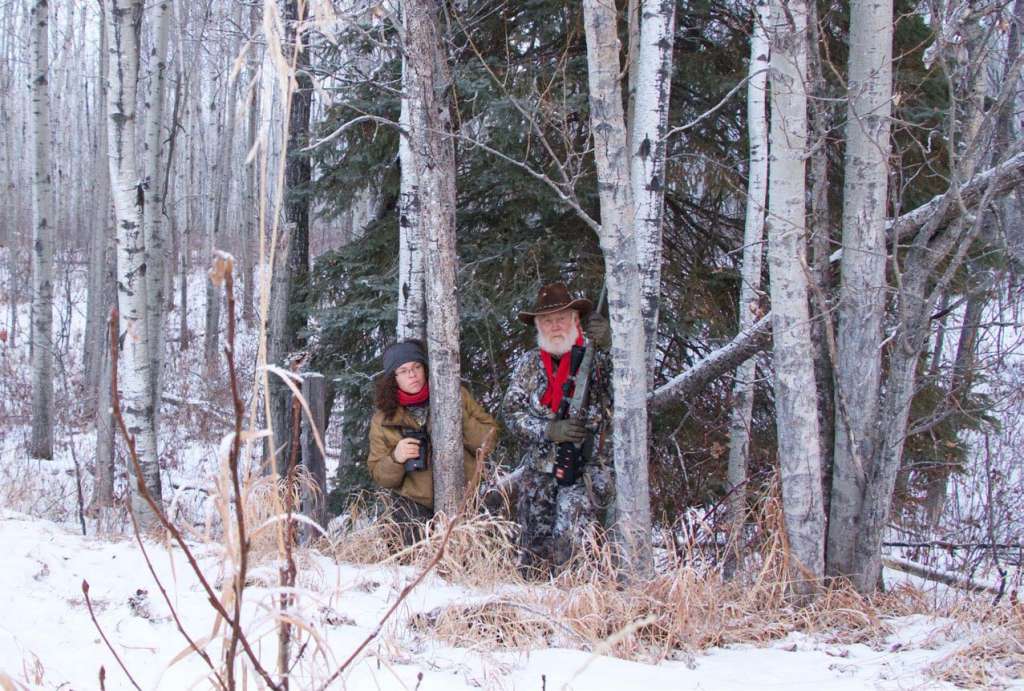“Why did you not shoot that buck? He walked to within less than 20 feet of where you were hidden under that pile of corn stalks,” exclaimed the smiling neighboring farmer when I walked back to my pickup, which was parked at his gate.
I simply shook my head. For most of the Iowa late muzzleloader season, I had targeted and hunted one individual buck. He was “just an eight-point,” but that eight-point carried antler mass the size of a soft-drink can from just above his antler burs to nearly the end of his tines. His shortest tines were his brow tines, at 10 inches. His matched back tines were easily 12 inches. His front tines were also nearly that long, and his gnarly beams had to approach 30 inches. His inside spread was somewhere around 24 to 26 inches. He was one of, if not THE biggest, eight-point bucks I had ever seen. Not only were his antlers huge, but they were also stained dark brown with polished ivory tips.
The buck seemed to live on adjoining property. He usually came in to feed on a largely harvested cornfield where I had permission to hunt. He came to our property across a wide-open field of knee-high grass from a creek bottom some distance beyond our neighbor’s property.
I had come close to getting a shot at him a couple of times before. One evening, the buck came within about 300 yards of me. I was waiting in a grain trailer I had pulled into the field to use as a blind. Back then, I felt comfortable shooting out to 150 yards with my Knight MK-85.50, shooting Hornady 250-grain SST Sabots, propelled by 150-grains of Hodgdon’s Pyrodex.

Then came the last afternoon of the season. I crawled into my hide nearly three hours before sundown. It was cold— horribly cold—and spitting snow. A stout, Arctic wind blew from the north. A full hour before sundown, does began coming into the field. At 40 minutes before sundown, a monstrous-bodied deer walked in. He headed directly toward where I lay hidden, then stopped 20 paces away. He was so close that I could see reddish spots on his head where his massive rack had previously been attached. It was likely that “my” buck had shed his antlers just in the last few hours or so.
So, when questioned by the grinning farmer, I knew that he well knew full well why I had not shot THE buck!
A couple of weeks later, when I was back home in Texas, I got a call from that farmer. “You know that buck you hunted, the big eight,” he knowingly asked. “Found his sheds. Found them both where he jumped the barbedwire fence coming into my place, about a quarter mile from where you hunted.” He continued, “You were right, his antlers are huge. My son scored just horns, no spread. Want to guess what they scored?” (I wanted to know, but also did not want to know!) “Giving him a 20-inside spread…182! Pretty big eight-point!”
Pretty big eight-point indeed, I thought!
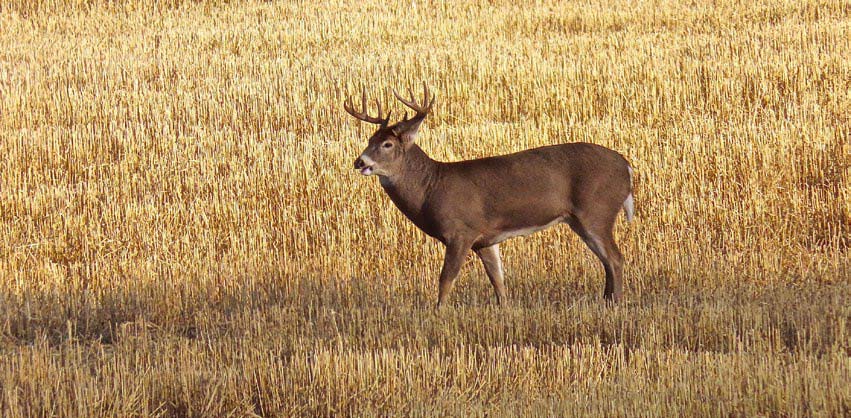
Looking at the Bright Side
Disappointing? Well, YEAH! But, in many ways, a win. A successful hunt. No doubt that on that last afternoon, I could have shot the buck I had hunted for numerous days. I decided I had essentially bested him by hunting a late-season food source, anyway. By then, most ground vegetation was covered with several inches of snow. The rather large field of harvested corn provided some feed, corn that, for whatever reason, fell to the ground rather into the grain trailer, later covered with snow.
Turkeys scratched through the snow to look for the kernels of corn that “escaped” the harvest. Deer did the same and followed the turkeys. Interestingly, on several previous occasions when I have hunted back in the woods in the Midwest, I followed turkeys as they scratched under oak trees looking for snow-covered acorns. Hungry Whitetailed deer closely followed the turkeys.
Value in Forage Crops

I hunted another buck in Central Iowa years ago. I initially watched him being chased across a frozen lake by a pack of local mongrels. He was wide and long mainbeamed. He had eight points, plus a split brow and a short drop-tine on his left side. Had he been closer I would have taken a shot, but he was more than 200 yards away and moving really fast. Realizing I was not going to get a shot, I switched to my 10x binoculars. Instead, I got a really good look at his antlers, thinking he would gross in the mid-170’s B&C.
I caught up with him the last afternoon of late muzzleloader season only minutes before sundown. Toby Bridges and I were still hunting in a long finger of trees and brush. The finger was about 20 yards wide, then fell quickly and deeply into creek bottoms on either side. The wind was stout to say the least, and it was blowing directly in our face.
When I spotted the buck, he was bedded under a cedar 25 paces away. He stood up and I raised the .50 MK-85. (Back then, I often hunted with, or on, hunts set up by Tony Knight, who did much to bring back muzzleloader hunting when in 1985 he introduced his version of the inline muzzleloader—changing the world of muzzleloader rifles!)
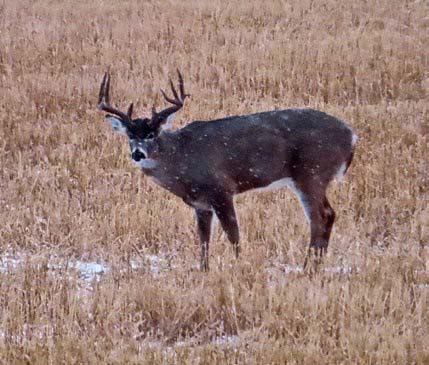
Making certain he was down for good after a prayer of thanks, I admired his rack. He was the same buck I had seen earlier being chased by dogs across the frozen lake. That night back at camp, we measured his main beams. They were, 30½ on one side and 31½ on the other. He had a 27-inch inside spread. His antlers later gross-scored 178 B&C and netted about 160. He had uneven matching tine lengths. I did not care! He remains one of my all-time favorite Whitetails, and certainly the buck with the longest main beams I have ever taken.
He had also truly been a last-minute Whitetail, taken during the waning moments of the season. My hunting near a food source had led to his undoing. The tall finger ridge had creeks on either side. Just beyond the creeks were harvested grain fields of corn and soybean, with a decent amount of food that did not make it onto the farmer’s grain trailer. All were late season hunt food sources!
Yes, Honeysuckle as Good Browse
Years ago, I hunted heavily forested country pine plantations, large areas of planted pines of varying heights. Tall, thickly planted pines seldom have deer browse growing underneath their boughs. Biologically, these areas are pretty much a desert. However, on the edge of these pines and where younger pine trees exist along with various browse species are areas that provide late winter forages for deer.
One of the plants often found in these areas is Japanese honeysuckle. Before you throw up your hands in disgust and think, “This guy’s an idiot because he’s talking about honeysuckle as a deer food source,” let me say: To the contrary! Most species of honeysuckle are not good deer browse. But deer do eat Japanese honeysuckle. In part of the South and Southeast, this viney plant is one of the very few plants that produces green forage during the winter. Based on my personal experiences in numerous areas, Japanese honeysuckle is not only a desired wintertime browse of Whitetail deer, but it also responds well to fertilization. Deer seek out fertilized plants over unfertilized plants. I create “natural” winter food plots by fertilizing (using 13-13-13) patches of Japanese honeysuckle and, in doing so, produce more forage and a higher quality forage. Hunting areas where I have fertilized patches, or even where I’ve had individual Japanese honeysuckle plants, have led to the undoing of several mature last-moment bucks.
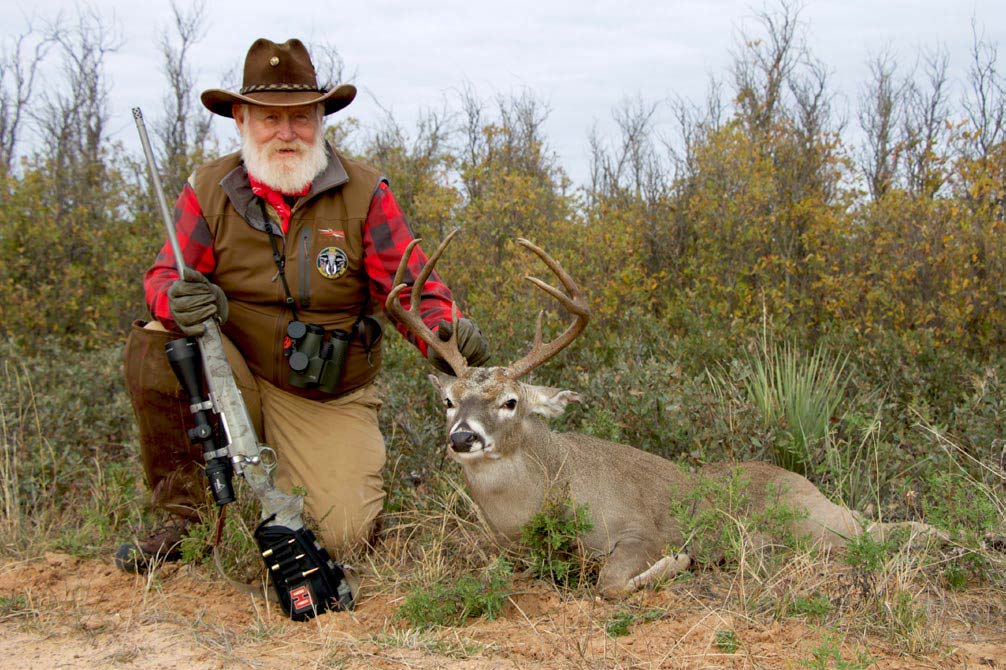
Thus far I have addressed primarily hunting late-season food sources. In deep Southern Texas, the famed South Texas Brush Country, our current Texas Managed Lands Deer Permits (MLDP) season allows hunting Whitetails on such permitted properties through the end of February.
Traditionally the Whitetail rut in the Texas Brush Country begins about mid-December and often lasts into mid-January. But that does not factor in doe fawns having their first estrus cycle in late January and sometimes even into February.
We did some research several years ago on extremely well-managed ranches where deer never went hungry a day of their lives. We learned that in these locations, as high as 80% of the doe fawns born in late June and July had their first estrus cycle in late January and early February, creating somewhat of a secondary rut. This is a situation when, on occasion, bucks that have been extremely secretive throughout the year and who are primarily nocturnal start making appearances during daylight hours.
If one is fortunate enough to hunt the winter season on these ranches, there is a really good chance of taking a true old monarch of the brush, i.e., “muy grande.”
Hunting such places takes patience and knowing where to hunt. Sites of food availability are still the primary places to look for young does. Bucks frequent these places for two reasons: hunger and sex (the two greatest motivators for movement).
Better Late Than Never
Late season hunting? There is still time in some states.
Just because the deer hunting season is closed in your area, you can still use this time to head to the deer woods to learn all you can about the local deer herd and where they live during the winter. In some areas, bucks in January or February have started casting or shedding their antlers. Late winter is an ideal time to do some scouting if you can’t hunt.
In late winter, I head to areas I avoided during the hunting season, such as sanctuaries that were set aside and other areas where I get to hunt. I look for rubs and scrapes and especially for shed antlers.
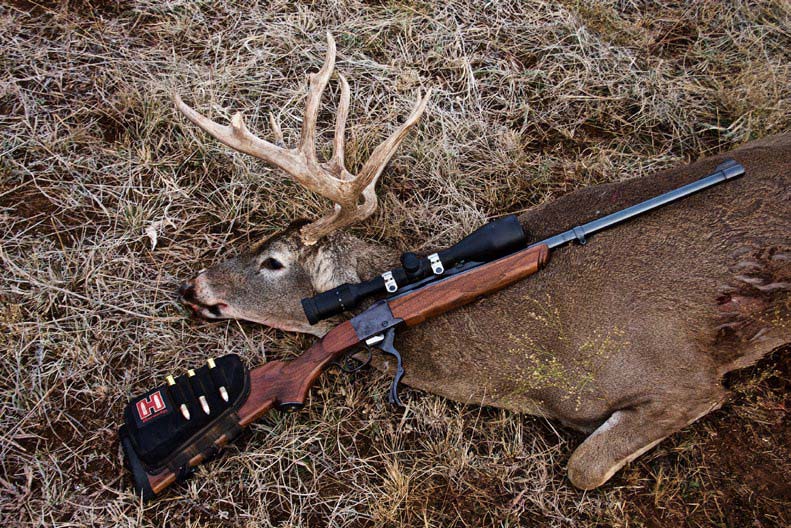
Finding shed antlers from mature Whitetails tells me where they were at the moment their antlers were cast. Interestingly, on properties where I have been involved as a wildlife biologist and/or hunter, we have often taken particular bucks whose cast antlers were found in late winter/early spring. They were discovered within 100 yards of where we found their sheds the following hunting season.
Winter? Hunt deer where you can! If deer season is closed due to some predator hunting (specifically coyotes), your taking a coyote might just save the buck fawn that can grow into the buck of a lifetime. Along the way, do a bit of scouting in preparation for next fall. The time has never been better to do so!
By Larry Weishuhn
Per our affiliate disclosure, we may earn revenue from the products available on this page. To learn more about how we test gear, click here.



